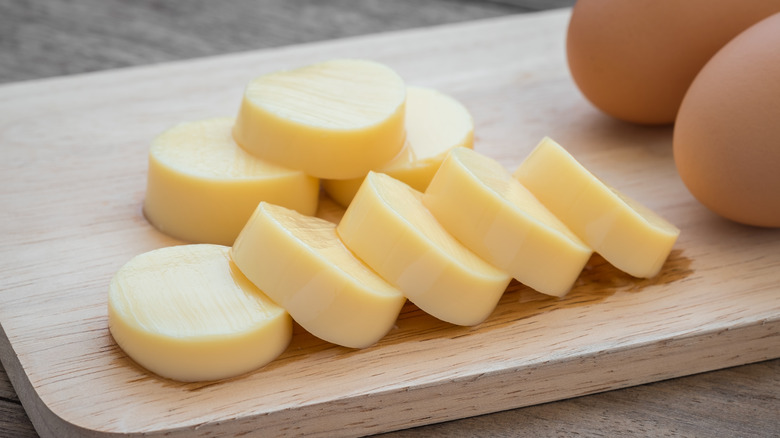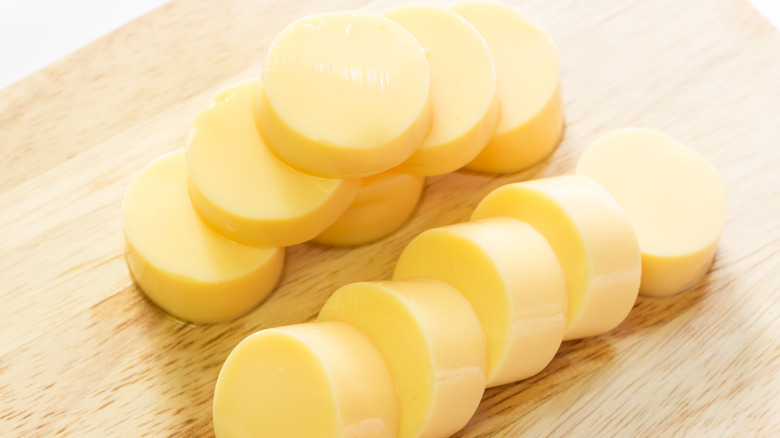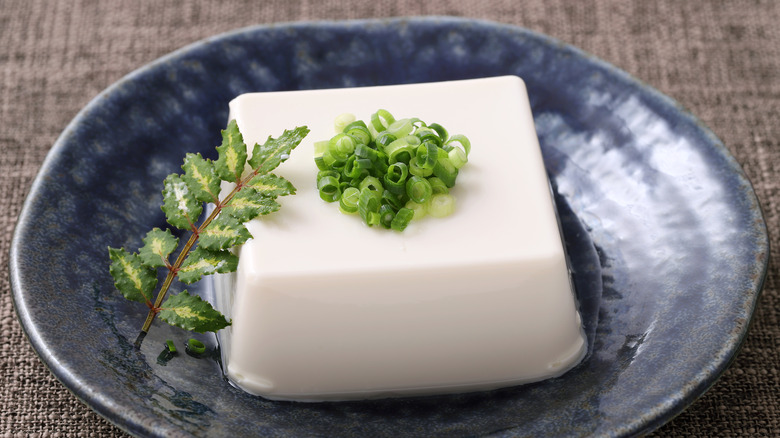The Differences Between Egg Tofu And Silken, Explained
You may have heard that silken tofu is a great egg substitute in all kinds of recipes, from baked goods to creamy soups and even making your own vegan mayo — what you might not have considered is the idea that eggs could be a substitute for tofu in any shape or form. As unlikely as it sounds, the substitution does work in reverse, to a degree: Smooth, mild, and almost gelatinous, egg tofu is very much a real thing that's often likened to silken tofu in terms of taste and texture.
So, what's the difference between the two? The most obvious one is that silken tofu is vegan, whereas egg tofu is not — by the same token, egg tofu is a safe alternative for those who have a soy allergy and need to avoid tofu in any form. Apart from that, they do have a remarkably similar texture and very subtle differences in taste. However, despite some claims that the two are mostly interchangeable, the actual practicality of using egg tofu as a substitute for silken tofu is largely unconfirmed.
What is egg tofu?
In contrast to how ubiquitous tofu is across East Asia, you'll find that any mentions of egg tofu usually refer to the specifically Japanese dish, tamago tofu. Unlike silken tofu, it's something of a rare find, even in specialty Asian grocery stores. Thankfully, it's not too difficult to make at home: The process of making egg tofu mostly involves mixing egg, dashi, and soy sauce, then carefully steaming the mixture in low heat so that it develops the signature silky texture instead of cooking into something more reminiscent of an omelet.
Despite its comparisons to silken tofu, it's actually more closely related to chawanmushi, a kind of Japanese egg custard. In fact, if you increased the amount of dashi in the egg mixture and then added things like mushrooms or shrimp, you'd end up with a serving of chawanmushi instead of plain egg tofu. The most conventional way of eating egg tofu is eating one block, either over rice or by itself, topped with a salty soy sauce mixture. However, a quick search of egg tofu online will net you a handful of recipes to incorporate it into other dishes like stir-fries or savory omelets.
How is it different from silken tofu?
In general, egg tofu is slightly more firm than silken tofu, though they still have a similar mouthfeel. As a result, it's somewhat easier to handle and use in pan-fried dishes, while silken tofu is very likely to fall apart before getting any kind of crispy char. While tasting more or less like silken tofu with a slightly more savory, egg-like taste when raw, egg tofu takes on the rich aroma and flavor of a good scramble or omelet when cooked.
Because egg tofu is not a specifically well-known phenomenon outside of Japan, you may have a hard time finding documented instances of or advice for using it in non-Japanese silken tofu dishes. While it's theoretically more than viable, you may have to do some personal experimentation when it comes to using egg tofu in things like map tofu or soft tofu soup. However, when it comes to sweet silken tofu concoctions like smoothies and other desserts, it might be best to stick to normal tofu. Where the subtly nutty taste of silken tofu might pair well with sweetness, the savory umami of the dashi present in egg tofu probably won't make the best match.


